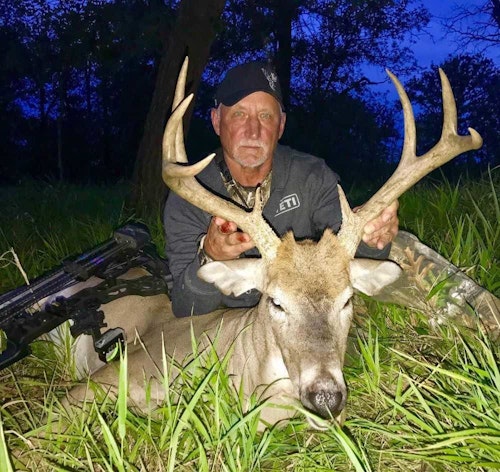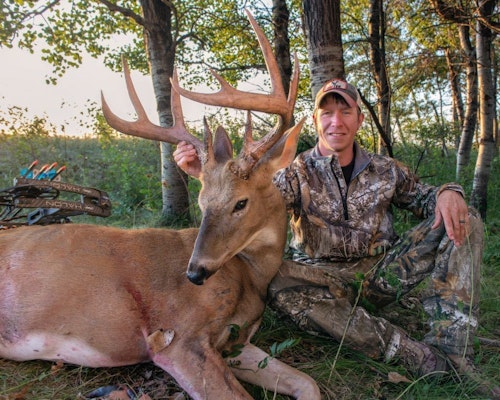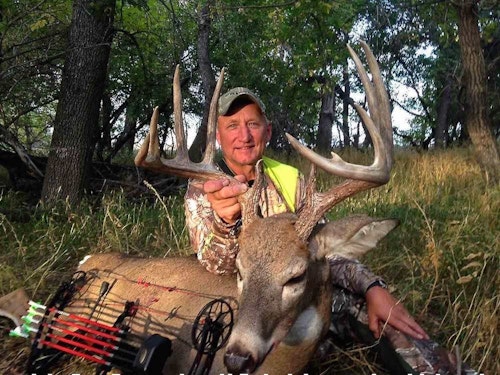
This scouting camera photo of a mature buck put the author's hunting partner in position to take the deer later that same day.
It’s that time all us bowhunters so look forward to — opening day of deer season! For some of us, this means our home state opener; for bowhunting road-trippers, it can mean opening day in another state.
While anticipation and hopes might run high for some quick success, the sad reality is a fair number of bowhunters head into early season ill prepared to actually tag a mature buck. Heck, I know a lot of hunters from my neck of the woods who, beyond putting out a few trail cameras, don’t do much of anything in the way of trying to improve their early season odds.
The plain truth of the matter is that merely putting out trail cameras should in no way be considered a thorough job of actually scouting. This is because there are a number of other key factors concerning early season whitetails that need to be taken into consideration.
Dealing With the Transition
More than anything, bowhunters must keep in mind that the whitetail herd as a whole is going through a major transition during the early season. While antlerless deer may stay consistent with their behavior, mature bucks definitely don’t. In many instances, their personalities and behavior undergo a very dramatic transformation.
For starters, mature bucks suddenly begin to display a bit of aversion to hanging out with the rest of the deer herd. And they often display a real love for nocturnal movement. But even more notably, mature bucks sometimes can display the irritating habit of relocating their travel and feeding activities to totally different locations during the early season period.
The main reason for these sudden changes has to do with something I’ve come to call the “transition period.” It’s that time of year when velvet shedding occurs, bachelor groups start breaking up, and certain preferred foods begin disappearing, while others suddenly come into play. And then a bunch of humans (us bowhunters) invade the woods.
While early season bucks seldom totally desert their core areas, a sudden decrease in foliage, availability and location of preferred foods, and a dramatic increase in human intrusion into their domains often will see them relocate at least somewhat, and in some instances quite significantly.
It’s my opinion that the sudden shifts in preferred foods continues to baffle early season bowhunters more than anything. In the event you disagree with me on the subject, I’d like you to consider something. Some years ago researchers at the University of Wisconsin did a study on the feeding preferences of whitetail deer in the state. In the end, researchers documented that Wisconsin whitetails included 300-plus different food items in their diets.
What this means is bowhunters need to vastly broaden their scope of knowledge when it comes to figuring out exactly what the big bucks in their hunting areas most prefer to eat at very specific times during early season. Trust me, it encompasses more than just the widely recognized deer foods, i.e., alfalfa, soybeans, corn and acorns.
Case in Point
A recent early season bowhunt in North Dakota is a perfect example of how quickly and dramatically things can change with mature whitetails. North Dakota’s 2018 archery deer season opened at noon on August 31st. My buddy Matt Tande and I had made plans to spend the first week of the season hunting a 7,000 acre ranch located in the northwestern part of the state.
In an attempt to gain a bit of an edge for our week-long bowhunt, Matt and I decided to make a whirlwind trip to the ranch. It’s legal to feed and bait deer in North Dakota, so along with putting up four feeders, we also hand broadcasted some Big Tine deer supplement in a half-dozen other spots. And, of course, we put up scouting cameras to monitor buck activity by all our feeding stations.
Another thing we did on that trip was spend two evenings watching a lush alfalfa field located along the landowner’s 2-mile-long private driveway. I can’t begin to explain just exactly how many large racked whitetails we saw feeding in the field during our two observation missions. Suffice to say it was more than a dozen! Matt and I made the 9-hour drive back to our home state of Wisconsin with great expectations for our upcoming bowhunt.
We arrived back at our North Dakota hunting destination in late afternoon on the day prior to the archery deer season opener. Because it was so late, we decided to wait until the following morning to check the 10 scouting cameras we’d put out earlier. While we did have dozens of photos of big bucks on our cameras, we also made a couple startling discoveries.
The closer it got to the opening of archery season, the fewer photos of big bucks we captured. And though we had anticipated that we’d be hunting for velvet bucks, the vast majority of the mature bucks we had on camera had already polished their antlers.
The main reason I cite our experience in North Dakota is because the 7,000-acre ranch we were hunting gets very little hunting pressure. Truth is, the woman who owns the ranch allows absolutely no gun hunting, and lets only 10 bowhunters onto her property each year. So the deer on her ranch are subjected to a very minimal amount of hunting pressure. Even so, the resident mature bucks are far from pushovers.
But this is usually the case with older whitetails. And as any experienced trophy whitetail bowhunter knows, mature bucks often do display significantly different behavior after they shed their velvet. They become a bit more reclusive, and almost always make changes to both their travel patterns and travel times.
Anyway, I finally got the ball rolling on day four of our hunt when I arrowed an old, brute-bodied 8-pointer. But the highlight of our trip came when Matt arrowed a heavy-horned 9-pointer the very next evening. The events leading up to Matt’s successful hunt bear mentioning.

It Pays to Be Observant
We’d actually first learned about the buck Matt killed while we were hunting a different spot a couple evenings earlier. The sun had just slipped below the western horizon when I noticed a big deer walking across a large stretch of prairie ground a good half-mile away. Even at that distance, Matt and I could clearly see that the deer sported large antlers.
We watched the buck until he was a mere speck on the horizon, and were able to ascertain that he was heading for a large, irrigated alfalfa field located on a neighboring landowner’s property. Interestingly, while making his way across the prairie ground, the big deer had walked well within bow range of several small clumps of thick brush.
Mid-morning the next day found Matt and I scouting the area where we’d seen the big buck. Right off we discovered that the isolated clumps of brush were both larger and thicker than we’d previously believed. We also knew it was the perfect scenario for a pop-up ground blind. Thirty minutes later, we had a ground blind in place and thoroughly brushed in. Just before leaving the area, we put up a scouting camera to monitor deer activity in front of the blind.
Recent big buck action at some other spots prevented us from checking the camera for a couple days. But when we finally did check it we discovered that a big, heavy-horned 9-point buck had walked in front of the blind in broad daylight that very morning. Matt knew instantly that he needed to be in the blind later that afternoon. It proved to be a wise decision, as he ended up arrowing the 9-pointer just as the sun was setting.
Later, while looking through some scouting camera photos from earlier in our hunt, we made an interesting discovery. We’d actually captured several photos of the 9-pointer at another location more than a mile from where Matt ended up arrowing the deer.
The reason I bring up this up is because it illustrates an important point about a particular aspect of early season buck behavior: Travel and feeding patterns can change dramatically literally from one day to the next. Matt’s buck had been consistently traveling to and feeding in a lush alfalfa field located on another part of the ranch. But for some reason he had suddenly relocated his feeding attentions to the neighbors alfalfa field. That field is well over 2 miles away!
This wasn’t the first time I’d witnessed such behavior during the early season period. Truth is, I’ve long preached the importance of hunters always keeping an ear to the ground regarding what deer are eating at specific times throughout the entire hunting season. Whitetails can be gorging on acorns for a while, then suddenly switch their feeding attention to alfalfa, soybeans, corn or some type of preferred browse.
Matt’s North Dakota experience shows that it’s imperative hunters don’t hesitate when they discover exploitable buck patterns. Waiting just a few days to put the hunt on those deer can sometimes be too long.

Don’t Get Careless
One of the biggest mistakes I made during the formative years of my trophy whitetail hunting career was assuming that mature deer didn’t pay much attention to their surroundings during early season. This belief was based largely on how I witnessed big bucks behaving at this time. Rather than being secretive and suspicious, they appeared to be quite obvious and even somewhat careless.
But what I quickly learned was just how little human intrusion it took for those deer to abruptly abandon their current patterns and adopt new ones. Because mature bucks aren’t being sidetracked in the least by the breeding urge, they’re able to pay much closer attention to their surroundings, which means they miss very little of what’s going on within their core areas.
Of course, there are exceptions to much of what I’ve written in this article. There certainly are instances where mature bucks definitely will reside within relatively small areas for almost the entire early season. They’ll bed, travel, eat, drink and go about their business in specific areas from the early fall period all the way up to the pre-rut. I’ve come to call bucks like this “homers” because they seldom leave their home ranges until the rut is about to begin.
There also are instances where mature bucks will have developed more of a tolerance to human presence and activity during early season. In almost every instance where I’ve seen examples of this, it was brought about by farmers and/or ranchers who were out and about on their properties almost on a daily basis. Because the farmers did the same things in the same places every time they were out and about, the resident whitetails didn’t perceive them as any type of threat. I had the good fortune to stumble upon a deer like this in western South Dakota a few years back.
In this case, the rancher who owned the property had been making daily trips into the area with his pickup. He’d check on his large herd of beef cattle and several water tanks. He’d also take one crop of baled hay from several nearby fields each summer. As a result, the resident whitetails had developed an amazing tolerance for vehicle traffic on the field roads that crisscrossed the property.
Based on some existing buck sign I’d found, I decided to place my treestand in an old cottonwood that stood in the middle of a narrow finger of timber. There were hayfields on both sides of the finger, and a small river about 200 yards to the south of my stand site.
The 10-pointer made an appearance a full hour before dark. He was moving along at a steady walk and headed straight for the tree where I was perched. Thankfully, the big deer began to alter his course just enough to ensure that I’d be offered a broadside shot. I let him close the distance to a mere 15 yards before voice grunting him to a stop. I sent a WASP Drone broadhead through his vitals. The buck immediately took off, but I heard him crash to the ground after running just a short distance.

There’s nothing quite like the feeling of having a filled archery deer tag right out of the gate, especially when that tag is affixed to a mature buck. While the early season period will always provide plenty of challenges, realizing success often times requires only some slight tweaks to your current hunting style. Hopefully, I’ve provided some insight into how to go about doing just that.





